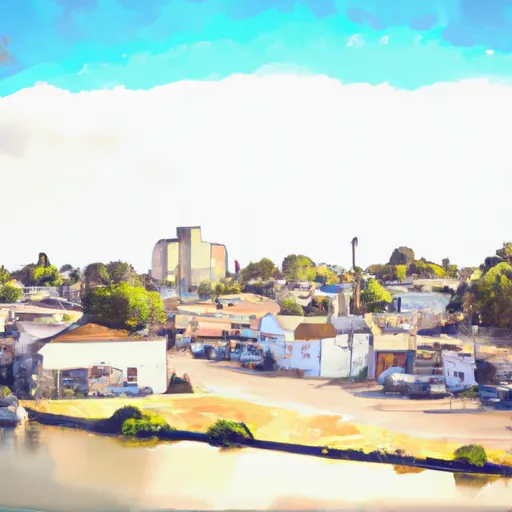-
 Snoflo Premium
Snoflo Premium
Get unlimited access to all our content
With no Ad interruptions! - Start Your Free Trial Login with existing account
Isleton
Eden Index
Climate
9.4
•
Recreation
3.8
•
Community
1.0
•
Safeguard
5.3/10

Isleton, California is a small town located in the Sacramento-San Joaquin River Delta region. With a Mediterranean climate, Isleton experiences hot, dry summers and mild, wet winters. Summers are typically very dry with temperatures often exceeding 90°F (32°C), while winters are cooler with temperatures ranging from 40°F (4°C) to 60°F (15°C), accompanied by rainfall.
Being situated in the Delta region, Isleton is surrounded by waterways. The Sacramento River flows along the east, providing opportunities for boating, fishing, and water sports. The Mokelumne River flows along the west, offering scenic views and recreational activities such as kayaking and canoeing. The local marshes and wetlands attract birdwatching enthusiasts with diverse bird species.
Hydrologically, Isleton experiences periodic flooding due to its proximity to the rivers. The town is protected by levees that help mitigate the risk of flooding, although flooding can still occur during extreme weather events.
In addition to water-based activities, Isleton offers outdoor recreation options such as hiking, biking, and picnicking in nearby parks and nature preserves. These opportunities allow residents and visitors to enjoy the natural beauty of the Delta region.
What is the Eden Index?
The Snoflo Eden Index serves as a comprehensive rating system for regions, evaluating their desirability through a holistic assessment of climate health, outdoor recreation opportunities, and natural disaster risk, acknowledging the profound impact of these factors on livability and well-being.
Climate Health Indicator (CHI): 9.4
Isleton receives approximately
444mm of rain per year,
with humidity levels near 58%
and air temperatures averaging around
16°C.
Isleton has a plant hardyness factor of
9, meaning
plants and agriculture in this region tend to thrive here all year round.
By considering the ideal temperature range, reliable water supplies, clean air, and stable seasonal rain or snowpacks, the Climate Health Indicator (CHI) underscores the significance of a healthy climate as the foundation for quality living.
A healthy climate is paramount for ensuring a high quality of life and livability in a region, fostering both physical well-being and environmental harmony. This can be characterized by ideal temperatures, reliable access to water supplies, clean air, and consistent seasonal rain or snowpacks.
Weather Forecast
Streamflow Conditions
Lower Sacramento
Area Rivers
Lower Sacramento
Snowpack Depths
Lower Sacramento
Reservoir Storage Capacity
Lower Sacramento
Groundwater Levels
Recreational Opportunity Index (ROI): 3.8
The Recreational Opportunity Index (ROI) recognizes the value of outdoor recreational options, such as parks, hiking trails, camping sites, and fishing spots, while acknowledging that climate plays a pivotal role in ensuring the comfort and consistency of these experiences.
Access to outdoor recreational opportunities, encompassing activities such as parks, hiking, camping, and fishing, is crucial for overall well-being, and the climate plays a pivotal role in enabling and enhancing these experiences, ensuring that individuals can engage in nature-based activities comfortably and consistently.
Camping Areas
| Campground | Campsites | Reservations | Toilets | Showers | Elevation |
|---|---|---|---|---|---|
| Westgate Landing Regional Park | 14 | -12 ft | |||
| Brannan Island State Rec Area | 127 | 19 ft | |||
| Contra Costa County Fair RV Park | 24 | 21 ft | |||
| Sandy Beach County Park | None | 27 ft |
Nearby Fishing
Catastrophe Safeguard Index (CSI):
The Catastrophe Safeguard Index (CSI) recognizes that natural disaster risk, encompassing floods, fires, hurricanes, and tornadoes, can drastically affect safety and the overall appeal of an area.
The level of natural disaster risk in a region significantly affects safety and the overall livability, with climate change amplifying these risks by potentially increasing the frequency and intensity of events like floods, fires, hurricanes, and tornadoes, thereby posing substantial challenges to community resilience and well-being.
Community Resilience Indicator (CRI): 1.0
The Community Resilience Indicator (CRI) recognizes that education, healthcare, and socioeconomics are crucial to the well-being of a region. The CRI acknowledges the profound impact of these elements on residents' overall quality of life. By evaluating educational resources, healthcare accessibility, and economic inclusivity, the index captures the essential aspects that contribute to a thriving community, fostering resident satisfaction, equity, and social cohesion.

